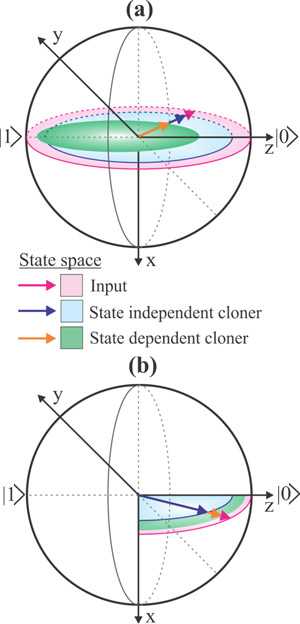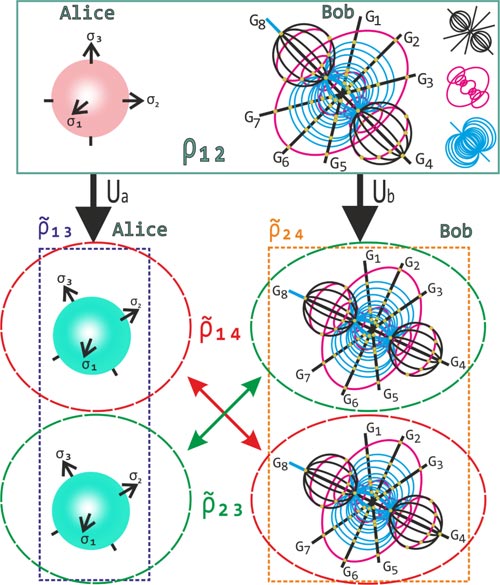 Quantum properties, namely entanglement, discord and coherence, are fundamental resources using which quantum networks perform information processing tasks. Consequently, the technique of decompressing these resources, or generating more such resources like broadcasting, serves as a promising candidate for the design of quantum networks.
Quantum properties, namely entanglement, discord and coherence, are fundamental resources using which quantum networks perform information processing tasks. Consequently, the technique of decompressing these resources, or generating more such resources like broadcasting, serves as a promising candidate for the design of quantum networks.
Researchers from Raman Research Institute (RRI) an autonomous institute under the Department of Science & Technology, Govt. of India introduced a new concept of orthogonal & non-orthogonal state-dependent cloners of quantum states which they found effective in broadcasting of entanglement in qubit-qubit (the basic unit of quantum information) systems.
Entangled states are key resources to facilitate many quantum information processing tasks and quantum cryptographic protocols. This new concept can help develop a cost-effective approach to perform information processing in large quantum networks like teleportation, dense coding, distributed, and blind quantum computing.
Quantum entanglement is one of the peculiarities of quantum mechanics, which makes phenomena such as quantum teleportation and super-dense coding possible. A single pair of entangled states can be converted into more pairs of less entangled states from a given entangled state with the help of broadcasting or decompression. One way of doing this is by applying cloning transformations on each qubit of the given entangled state.
The scientists have extensively analysed the boundaries of decompressing correlations from a resource correlated state shared between two parties to more such pairs and provided a comprehensive outline of its possibilities and impossibilities in qubit-qudit dimensions- Such a procedure can help to perform quantum information tasks between an increased number of parties.
Though the techniques of cloning and broadcasting of quantum states have previously been published in the literature, the work by RRI team published in the journal Quantum Inf. The process introduces a novel concept of state-dependent cloning from the perspective of orthogonality of machine states on which the efficiency of the cloning depends. The cloner (copying machine) itself needs to be configured in different (machine) states for copying the coordinates (bases states). The efficiency of the state-dependent cloning depends on the orthogonality of these machine states.
More particularly, it provides fresh analytical results that illustrate how these versions of state-dependent cloner outperform their state independent counterparts in broadcasting entanglement.
In the research published in Physical Review, the team proceeds beyond previous studies on broadcasting of quantum resources in qubit-qubit scenario and proved the fundamental impossibilities associated with the broadcasting of resources in 2xd dimensions (where d represents an integer greater than 2). The results highlight a basic difference between the correlation measures defined from the perspective of entanglement and those, such as discord, that claim to go beyond entanglement.
 The idea of this research was triggered from the fundamental question that if purification procedures exist for enabling compression of entanglement, how we can efficiently decompress quantum correlations. Broadcasting of quantum correlation refers to the technique of generating a larger number of less correlated pairs from a highly correlated pair, using local or nonlocal quantum operations. One such popular operation that facilitates broadcasting turns out to be quantum cloning.
The idea of this research was triggered from the fundamental question that if purification procedures exist for enabling compression of entanglement, how we can efficiently decompress quantum correlations. Broadcasting of quantum correlation refers to the technique of generating a larger number of less correlated pairs from a highly correlated pair, using local or nonlocal quantum operations. One such popular operation that facilitates broadcasting turns out to be quantum cloning.
While perfect cloning of an unknown quantum state is prohibited by the No-cloning theorem; modest approaches exist that enable approximate cloning of quantum states. Moreover, if we are provided with some knowledge about the probability distribution of the input states, then the cloning fidelity can be substantially improved. Based on these concepts and curiosities, the RRI team reconceptualised the idea of state-dependent (SD) cloning and highlight instances where the SD cloner outperforms its state-independent counterpart in broadcasting entanglement. They have also outlined the boundaries for broadcasting quantum resources (namely entanglement, discord and coherence), using state independent cloning operations beyond qubit-qubit dimensions.
Given a pair of highly correlated particles, the team used state-independent or state-dependent, local as well as nonlocal, cloning operations on them to create more number of correlated pairs. It is important to mention that these cloned pairs, of course, share a lesser correlation than the resource pair. Having obtained the cloned pairs, they analysed the range of state parameters for which they will remain correlated. This range finally becomes the broadcasting range for that resource pair and the quantum states contained therein are regarded as the ones useful for broadcasting quantum correlation. The cloned output pair lying within the broadcasting range can be potentially used for performing information processing tasks.
With the 21st century being regarded as the quantum age, information processing and secure communication exploiting the principles of quantum physics is gaining rapid popularity and also becoming commercially viable. A quantum network with entangled nodes can perform most information processing tasks by creating, distributing and processing quantum information. Precise routing and controlled manipulation of remote entanglement through the nodes of a quantum network would be a major stepping stone towards a quantum internet including various other applications such as precision sensing, distributed as well as blind quantum computing. In such a quantum network, there can always be an exigency in increasing the number of available correlated pairs across the various nodes. A tried and tested method of meeting this requirement is the broadcasting of correlations, via the application of local or nonlocal cloners, on qubit-qubit or even qubit-qutrit systems.
Caption Figure1: A schematic comparing the performance of a state-dependent (SD) versus a state-independent (SI) cloner on an input qubit, inside the Bloch sphere framework. The x, y, and z basis vectors are essentially the Pauli matrices. In subfigure (a), the pink circle traced azimuthally around the x basis represents the input state space of the qubit, which is to be cloned. As inputs, the illustration is restricted to pure states, so the pink vector can only move along its circumference (i.e., solid pink boundary). The output state space of the cloned qubit is depicted with a blue circle for the SI cloner and with a green elliptical envelope for the SD cloner. Similarly, in subfigure (b), a corresponding comparison is sketched, considering only one quadrant of the previous input state space. It symbolizes the case when prior information on a restricted range of input state parameters are available during the preparation of the SD cloner.
Caption Figure2: A schematic depicting the application of local cloning unitaries Ua and Ub on a qubit-qutrit state shared between Alice and Bob. The qutrit system (d = 3) on Bob’s side is illustrated with a three-sphere or glome structure in the four-dimensional Euclidean space. Stereographic projection of the hypersphere’s parallels (magenta), meridians (cyan), and hyper-meridians (black) are illustrated separately, as subfigures on the right column, beside the glome qutrit for clarity. The projection being conformal, the circular curves intersect each other orthogonally at the yellow points. The rectangular box with a solid olive-green boundary represents the input state ρ12; the dotted rectangular envelopes in blue and orange highlight the cloned local output pairs ρ13 and ρ24, respectively. Further, the dotted oval-shaped envelopes in red and green depict the cloned nonlocal output pairs ρ14 and ρ23, respectively.
Link to publications:






























